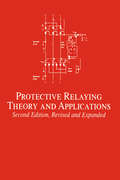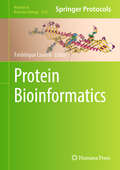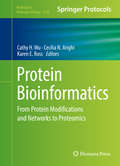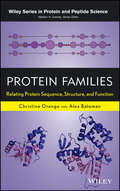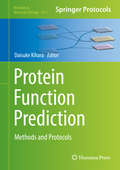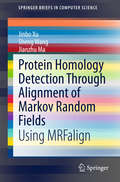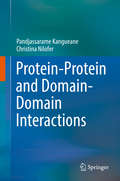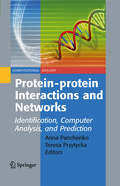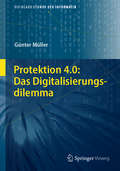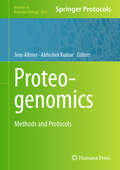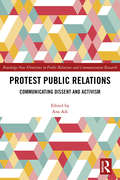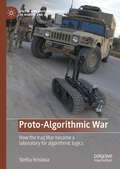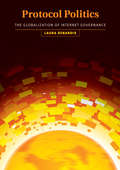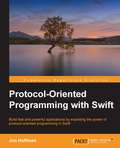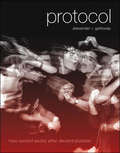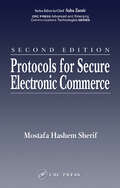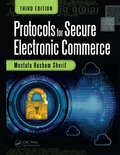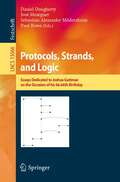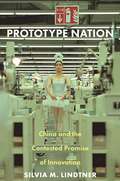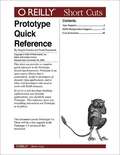- Table View
- List View
Protecting and Mitigating Against Cyber Threats: Deploying Artificial Intelligence and Machine Learning
by Ming Yang Suneeta Satpathy Sachi Nandan Mohanty D. Khasim ValiThe book provides invaluable insights into the transformative role of AI and ML in security, offering essential strategies and real-world applications to effectively navigate the complex landscape of today’s cyber threats. Protecting and Mitigating Against Cyber Threats delves into the dynamic junction of artificial intelligence (AI) and machine learning (ML) within the domain of security solicitations. Through an exploration of the revolutionary possibilities of AI and ML technologies, this book seeks to disentangle the intricacies of today’s security concerns. There is a fundamental shift in the security soliciting landscape, driven by the extraordinary expansion of data and the constant evolution of cyber threat complexity. This shift calls for a novel strategy, and AI and ML show great promise for strengthening digital defenses. This volume offers a thorough examination, breaking down the concepts and real-world uses of this cutting-edge technology by integrating knowledge from cybersecurity, computer science, and related topics. It bridges the gap between theory and application by looking at real-world case studies and providing useful examples. Protecting and Mitigating Against Cyber Threats provides a roadmap for navigating the changing threat landscape by explaining the current state of AI and ML in security solicitations and projecting forthcoming developments, bringing readers through the unexplored realms of AI and ML applications in protecting digital ecosystems, as the need for efficient security solutions grows. It is a pertinent addition to the multi-disciplinary discussion influencing cybersecurity and digital resilience in the future. Readers will find in this book: Provides comprehensive coverage on various aspects of security solicitations, ranging from theoretical foundations to practical applications; Includes real-world case studies and examples to illustrate how AI and machine learning technologies are currently utilized in security solicitations; Explores and discusses emerging trends at the intersection of AI, machine learning, and security solicitations, including topics like threat detection, fraud prevention, risk analysis, and more; Highlights the growing importance of AI and machine learning in security contexts and discusses the demand for knowledge in this area. Audience Cybersecurity professionals, researchers, academics, industry professionals, technology enthusiasts, policymakers, and strategists interested in the dynamic intersection of artificial intelligence (AI), machine learning (ML), and cybersecurity.
Protection of Information and the Right to Privacy - A New Equilibrium?
by Luciano FloridiThis book presents the latest research on the challenges and solutions affecting the equilibrium between freedom of speech, freedom of information, information security and the right to informational privacy. Given the complexity of the topics addressed, the book shows how old legal and ethical frameworks may need to be not only updated, but also supplemented and complemented by new conceptual solutions. Neither a conservative attitude ("more of the same") nor a revolutionary zeal ("never seen before") is likely to lead to satisfactory solutions. Instead, more reflection and better conceptual design are needed, not least to harmonise different perspectives and legal frameworks internationally. The focus of the book is on how we may reconcile high levels of information security with robust degrees of informational privacy, also in connection with recent challenges presented by phenomena such as "big data" and security scandals, as well as new legislation initiatives, such as those concerning "the right to be forgotten" and the use of personal data in biomedical research. The book seeks to offer analyses and solutions of the new tensions, in order to build a fair, shareable and sustainable balance in this vital area of human interactions.
Protective Relaying: Theory and Applications
by Walter A. ElmoreTargeting the latest microprocessor technologies for more sophisticated applications in the field of power system short circuit detection, this revised and updated source imparts fundamental concepts and breakthrough science for the isolation of faulty equipment and minimization of damage in power system apparatus. The Second Edition clearly descri
Protective Security: Creating Military-Grade Defenses for Your Digital Business
by Jim SeamanThis book shows you how military counter-intelligence principles and objectives are applied. It provides you with valuable advice and guidance to help your business understand threat vectors and the measures needed to reduce the risks and impacts to your organization. You will know how business-critical assets are compromised: cyberattack, data breach, system outage, pandemic, natural disaster, and many more. Rather than being compliance-concentric, this book focuses on how your business can identify the assets that are most valuable to your organization and the threat vectors associated with these assets. You will learn how to apply appropriate mitigation controls to reduce the risks within suitable tolerances. You will gain a comprehensive understanding of the value that effective protective security provides and how to develop an effective strategy for your type of business. What You Will Learn Take a deep dive into legal and regulatory perspectives and how an effective protective security strategy can help fulfill these ever-changing requirementsKnow where compliance fits into a company-wide protective security strategySecure your digital footprintBuild effective 5 D network architectures: Defend, detect, delay, disrupt, deterSecure manufacturing environments to balance a minimal impact on productivitySecuring your supply chains and the measures needed to ensure that risks are minimizedWho This Book Is For Business owners, C-suite, information security practitioners, CISOs, cybersecurity practitioners, risk managers, IT operations managers, IT auditors, and military enthusiasts
Protein Bioinformatics (Methods in Molecular Biology #2836)
by Frédérique LisacekThis detailed volume explores techniques for protein bioinformatics research, including databases, software tools, and computational methods, in the context of protein science or proteomics and opening to other omics areas. Beginning with a section on proteogenomics, the book continues by covering posttranslational modifications, processing large-scale mass spectrometry data, protein structure and interactions, as well as protein feature inference. Written for the highly successful Methods in Molecular Biology series, chapters include the kind of detailed implementation advice to ensure efficacious results. Authoritative and practical, Protein Bioinformatics serves as an ideal guide for researchers in disciplines encompassing the biotechnological, pharmaceutical, biological, and medical sciences, as well as the computational and engineering sciences.
Protein Bioinformatics: From Protein Modifications and Networks to Proteomics (Methods in Molecular Biology #1558)
by Cathy H. Wu Cecilia N. Arighi Karen E. RossThis volume introduces bioinformatics research methods for proteins, with special focus on protein post-translational modifications (PTMs) and networks. This book is organized into four parts and covers the basic framework and major resources for analysis of protein sequence, structure, and function; approaches and resources for analysis of protein PTMs, protein-protein interactions (PPIs) and protein networks, including tools for PPI prediction and approaches for the construction of PPI and PTM networks; and bioinformatics approaches in proteomics, including computational methods for mass spectrometry-based proteomics and integrative analysis for alternative splice isoforms, for functional discovery. Written in the highly successful Methods in Molecular Biology series format, chapters include introductions to their respective topics, lists of the necessary materials and reagents, step-by-step, readily reproducible laboratory or computational protocols, and tips on troubleshooting and avoiding known pitfalls.Cutting-edge and thorough, Protein Bioinformatics: From Protein Modifications and Networks to Proteomics is a valuable resource for readers who wish to learn about state-of-the-art bioinformatics databases and tools, novel computational methods, and future trends in protein and proteomic data analysis in systems biology. This book is useful to researchers who work in the biotechnology and pharmaceutical industries, and in various academic departments, such as biological and medical sciences and computer sciences and engineering.
Protein Families
by Alex Bateman Vladimir Uversky Christine OrengoNew insights into the evolution and nature of proteinsExploring several distinct approaches, this book describes the methods for comparing protein sequences and protein structures in order to identify homologous relationships and classify proteins and protein domains into evolutionary families. Readers will discover the common features as well as the key philosophical differences underlying the major protein classification systems, including Pfam, Panther, SCOP, and CATH. Moreover, they'll discover how these systems can be used to understand the evolution of protein families as well as understand and predict the degree to which structural and functional information are shared between relatives in a protein family.Edited and authored by leading international experts, Protein Families offers new insights into protein families that are important to medical research as well as protein families that help us understand biological systems and key biological processes such as cell signaling and the immune response. The book is divided into three sections: Section I: Concepts Underlying Protein Family Classification reviews the major strategies for identifying homologous proteins and classifying them into families. Section II: In-Depth Reviews of Protein Families focuses on some fascinating super protein families for which we have substantial amounts of sequence, structural and functional data, making it possible to trace the emergence of functionally diverse relatives. Section III: Review of Protein Families in Important Biological Systems examines protein families associated with a particular biological theme, such as the cytoskeleton.All chapters are extensively illustrated, including depictions of evolutionary relationships. References at the end of each chapter guide readers to original research papers and reviews in the field.Covering protein family classification systems alongside detailed descriptions of select protein families, this book offers biochemists, molecular biologists, protein scientists, structural biologists, and bioinformaticians new insight into the evolution and nature of proteins.
Protein Function Prediction
by Daisuke KiharaGene function annotation has been a central question in molecular biology. The importance of computational function prediction is increasing because more and more large scale biological data, including genome sequences, protein structures, protein-protein interaction data, microarray expression data, and mass spectrometry data, are awaiting biological interpretation. Traditionally when a genome is sequenced, function annotation of genes is done by homology search methods, such as BLAST or FASTA. However, since these methods are developed before the genomics era, conventional use of them is not necessarily most suitable for analyzing a large scale data. Therefore we observe emerging development of computational gene function prediction methods, which are targeted to analyze large scale data, and also those which use such omics data as additional source of function prediction. In this book, we overview this emerging exciting field. The authors have been selected from 1) those who develop novel purely computational methods 2) those who develop function prediction methods which use omics data 3) those who maintain and update data base of function annotation of particular model organisms (E. coli), which are frequently referred
Protein Homology Detection Through Alignment of Markov Random Fields
by Jinbo Xu Sheng Wang Jianzhu MaThis work covers sequence-based protein homology detection, a fundamental and challenging bioinformatics problem with a variety of real-world applications. The text first surveys a few popular homology detection methods, such as Position-Specific Scoring Matrix (PSSM) and Hidden Markov Model (HMM) based methods, and then describes a novel Markov Random Fields (MRF) based method developed by the authors. MRF-based methods are much more sensitive than HMM- and PSSM-based methods for remote homolog detection and fold recognition, as MRFs can model long-range residue-residue interaction. The text also describes the installation, usage and result interpretation of programs implementing the MRF-based method.
Protein-Protein and Domain-Domain Interactions
by Pandjassarame Kangueane Christina NiloferThis book illustrates the importance and significance of the molecular (physical and chemical) and evolutionary (gene fusion) principles of protein-protein and domain-domain interactions towards the understanding of cell division, disease mechanism and target definition in drug discovery. It describes the complex issues associated with this phenomenon using cutting edge advancement in Bioinformatics and Bioinformation Discovery. The chapters provide current information pertaining to the types of protein-protein complexes (homodimers, heterodimers, multimer complexes) in context with various specific and sensitive biological functions. The significance of such complex formation in human biology in the light of molecular evolution is also highlighted using several examples. The chapters also describe recent advancements on the molecular principles of protein-protein interaction with reference to evolution towards target identification in drug discovery. Finally, the book also elucidates a comprehensive yet a representative description of a large number of challenges associated with the molecular interaction of proteins.
Protein-protein Interactions and Networks
by Anna Panchenko Teresa M. PrzytyckaThe biological interactions of living organisms, and protein-protein interactions in particular, are astonishingly diverse. This comprehensive book provides a broad, thorough and multidisciplinary coverage of its field. It integrates different approaches from bioinformatics, biochemistry, computational analysis and systems biology to offer the reader a comprehensive global view of the diverse data on protein-protein interactions and protein interaction networks.
Protektion 4.0: Das Digitalisierungsdilemma (Die blaue Stunde der Informatik)
by Günter MüllerDas Buch beschreibt Datenschutz erstmals als Offenheit (Transparenz) statt Datensparsamkeit. Der Autor beschreibt als Voraussetzung dazu einen Besitztitel auf Daten. Die Umsetzung erfolgt über Big Data, deren Techniken so ausgelegt sind, dass Daten zur „handelbaren“ Ware werden können, indem dokumentierbar wird, wie von wem wozu Daten verwendet worden sind. Transparente Verwendung auch in Hinsicht auf den Nutzen oder die Notwendigkeit statt Verbergen wird als neues Privatheitsmodell vorgeschlagen. Die Synchronisation der Entwicklung von Technik und Gesellschaft steht dabei im Vordergrund. Zahlreiche Fallstudien erhöhen den praktischen Nutzen des Buches.
Proteogenomics: Methods and Protocols (Methods in Molecular Biology #2859)
by Jens Allmer Abhishek KumarThis volume presents an up-to-date overview of the current state-of-the-art protocols, and aims to put proteogenomics into a broader perspective. The chapters in this book detail methods and techniques ranging from mass spectrometry to proteomics and proteogenomics and their biomedical implications and applications. Written in the highly successful Methods in Molecular Biology series format, the chapters include introductions to their respective topics, application details for both the expert and non-expert reader, and tips on troubleshooting and avoiding known pitfalls. A highlight for everyone new to the field are the chapters, which put proteogenomics to use to answer biomedical questions. Authoritative and accessible, Proteogenomics: Methods and Protocols aims to ensure successful results in the further study of this vital field.
Protest Public Relations: Communicating dissent and activism (Routledge New Directions in PR & Communication Research)
by Ana AdiGlobal movements and protests from the Arab Spring to the Occupy Movement have been attributed to growing access to social media, while without it, local causes like #bringbackourgirls and the ice bucket challenge may have otherwise remained unheard and unseen. Regardless of their nature – advocacy, activism, protest or dissent – and beyond the technological ability of digital and social media to connect support, these major events have all been the results of excellent communication and public relations. But PR remains seen only as the defender of corporate and capitalist interests, and therefore resistant to outside voices such as activists, NGOs, union members, protesters and whistle-blowers. Drawing on contributions from around the world to examine the concepts and practice of "activist," "protest" and "dissent" public relations, this book challenges this view. Using a range of international examples, it explores the changing nature of protest and its relationship with PR and provides a radical analysis of the communication strategies and tactics of social movements and activist groups and their campaigns. This thought-provoking collection will be of interest to researchers and advanced students of public relations, strategic communication, political science, politics, journalism, marketing, and advertising, and also to PR professionals in think tanks and NGOs.
Proto-Algorithmic War: How the Iraq War became a laboratory for algorithmic logics (Social and Cultural Studies of Robots and AI)
by Stefka HristovaDuring the Iraq War, American soldiers were sent to both fight an enemy and to recover a “failed state” in pixelated camouflage uniforms, accompanied by robots, and armed with satellite maps and biometric hand-held scanners. The Iraq War, however, was no digital game: massive-scale physical death and destruction counter the vision of a clean replayable war. The military policy of the United States, and not the actual experience of war, has been rooted in the logic of digital, and nascent algorithmic technology. This logic attempted to reduce culture, society, as well as the physical body and environment into visual data that lacks cultural and historical context. This book details the emergence of a nascent algorithmic war culture in the context of the Iraq War (2003-2010) in relation to the data-driven early 20th century British Mandate for Iraq. Through a series of five inquiries into the ways in which the Iraq War attempted to and often failed to see population and territory as digital and further proto-algorithmic entities, it offers an insight into the digitization and further unmanned automaton of war. It does so through a comparative historical framework reaching back to the quantification techniques harnessed during the British Mandate for Iraq (1918-1932) in order to explicate the parallels and complicated the diversions between the numerical logics that have driven both military state-building enterprises.
Protocol Engineering
by Hartmut KönigCommunication protocols form the operational basis of computer networks and telecommunication systems. They are behavior conventions that describe how communication systems interact with each other, defining the temporal order of the interactions and the formats of the data units exchanged - essentially they determine the efficiency and reliability of computer networks. Protocol Engineering is an important discipline covering the design, validation, and implementation of communication protocols. Part I of this book is devoted to the fundamentals of communication protocols, describing their working principles and implicitly also those of computer networks. The author introduces the concepts of service, protocol, layer, and layered architecture, and introduces the main elements required in the description of protocols using a model language. He then presents the most important protocol functions. Part II deals with the description of communication protocols, offering an overview of the various formal methods, the essence of Protocol Engineering. The author introduces the fundamental description methods, such as finite state machines, Petri nets, process calculi, and temporal logics, that are in part used as semantic models for formal description techniques. He then introduces one representative technique for each of the main description approaches, among others SDL and LOTOS, and surveys the use of UML for describing protocols. Part III covers the protocol life cycle and the most important development stages, presenting the reader with approaches for systematic protocol design, with various verification methods, with the main implementation techniques, and with strategies for their testing, in particular with conformance and interoperability tests, and the test description language TTCN. The author uses the simple data transfer example protocol XDT (eXample Data Transfer) throughout the book as a reference protocol to exemplify the various description techniques and to demonstrate important validation and implementation approaches. The book is an introduction to communication protocols and their development for undergraduate and graduate students of computer science and communication technology, and it is also a suitable reference for engineers and programmers. Most chapters contain exercises, and the author's accompanying website provides further online material including a complete formal description of the XDT protocol and an animated simulation visualizing its behavior.
Protocol Politics
by Laura DenardisThe Internet has reached a critical point. The world is running out of Internet addresses. There is a finite supply of approximately 4.3 billion Internet Protocol (IP) addresses--the unique binary numbers required for every exchange of information over the Internet--within the Internet's prevailing technical architecture (IPv4). In the 1990s the Internet standards community identified the potential depletion of these addresses as a crucial design concern and selected a new protocol (IPv6) that would expand the number of Internet addresses exponentially--to 340 undecillion addresses. Despite a decade of predictions about imminent global conversion, IPv6 adoption has barely begun. IPv6 is not backward compatible with IPv4, and the ultimate success of IPv6 depends on a critical mass of IPv6 deployment, even among users who don't need it, or on technical workarounds that could in turn create a new set of concerns. Protocol Politics examines what's at stake politically, economically, and technically in the selection and adoption of a new Internet protocol. Laura DeNardis's key insight is that protocols are political. IPv6 serves as a case study for how protocols more generally are intertwined with socioeconomic and political order. IPv6 intersects with provocative topics including Internet civil liberties, U.S. military objectives, globalization, institutional power struggles, and the promise of global democratic freedoms. DeNardis offers recommendations for Internet standards governance based not only on technical concerns but on principles of openness and transparency and examines the global implications of looming Internet address scarcity versus the slow deployment of the new protocol designed to solve this problem.
Protocol Politics: The Globalization of Internet Governance (Information Revolution and Global Politics)
by Laura DenardisWhat are the global implications of the looming shortage of Internet addresses and the slow deployment of the new IPv6 protocol designed to solve this problem?The Internet has reached a critical point. The world is running out of Internet addresses. There is a finite supply of approximately 4.3 billion Internet Protocol (IP) addresses—the unique binary numbers required for every exchange of information over the Internet—within the Internet's prevailing technical architecture (IPv4). In the 1990s the Internet standards community selected a new protocol (IPv6) that would expand the number of Internet addresses exponentially—to 340 undecillion addresses. Despite a decade of predictions about imminent global conversion, IPv6 adoption has barely begun. Protocol Politics examines what's at stake politically, economically, and technically in the selection and adoption of a new Internet protocol. Laura DeNardis's key insight is that protocols are political. IPv6 intersects with provocative topics including Internet civil liberties, US military objectives, globalization, institutional power struggles, and the promise of global democratic freedoms. DeNardis offers recommendations for Internet standards governance, based not only on technical concerns but on principles of openness and transparency, and examines the global implications of looming Internet address scarcity versus the slow deployment of the new protocol designed to solve this problem.
Protocol-Oriented Programming with Swift
by Jon HoffmanBuild fast and powerful applications by exploiting the power of protocol-oriented programming in Swift About This Book * The only book that shows how to harness the power of Protocol-Oriented Programming in Swift to build real-world applications, * Get familiar with the protocol focused approach of application development, * Increase the overall productivity and performance of applications with Protocol Oriented Programming. Who This Book Is For This book is for Swift developers who want to learn and implement protocol oriented programming in their real world applications. What You Will Learn * The difference between Object-Oriented programming and Protocol-Oriented programming * The difference between reference and value types and when to use each * How we can leverage tuples to reduce the complexity of our code * What are protocols and how to use them * How to implement protocol extensions to create a very flexible code base * How to implement several design patterns in a Protocol-Oriented approach * How to solve real world design issue with protocol oriented programming In Detail At the heart of Swift's design is an incredibly powerful idea: protocol-oriented programming. Its many benefits include better code maintainability, increased developer productivity and superior application performance. The book will teach the reader how to apply the ideas behind the protocol oriented programing paradigm to improve the code they write. This book will introduce the readers to the world of protocol-oriented programming in Swift and will demonstrate the ideas behind this new programming paradigm with real world examples. In addition to learning the concepts of Protocol Oriented programming, it also shows the reader how to reduce the complexity of their codebase using protocol extensions. Beginning with how to create simple protocols, readers will learn how to extend protocols and also to assign behaviors to them. By the end of this book readers will be able to harness the power of protocol-oriented programming to build real world applications. Style and approach In its latest release of Swift, Apple has introduced Protocol Extensions as a new feature at the heart of Swifts design making Swift 2 a protocol-oriented language. Protocol oriented programming being a less explored OOP paradigm, there is little guidance on hot to take advantage of protocol extensions in real-world applications. In addition to offering an in-depth coverage of protocol oriented programming and its concepts, this book also explains how a developer can leverage these features to build powerful, real-world applications
Protocol: How Control Exists after Decentralization (Leonardo)
by Alexander R. GallowayHow Control Exists after DecentralizationIs the Internet a vast arena of unrestricted communication and freely exchanged information or a regulated, highly structured virtual bureaucracy? In Protocol, Alexander Galloway argues that the founding principle of the Net is control, not freedom, and that the controlling power lies in the technical protocols that make network connections (and disconnections) possible. He does this by treating the computer as a textual medium that is based on a technological language, code. Code, he argues, can be subject to the same kind of cultural and literary analysis as any natural language; computer languages have their own syntax, grammar, communities, and cultures. Instead of relying on established theoretical approaches, Galloway finds a new way to write about digital media, drawing on his backgrounds in computer programming and critical theory. "Discipline-hopping is a necessity when it comes to complicated socio-technical topics like protocol," he writes in the preface. Galloway begins by examining the types of protocols that exist, including TCP/IP, DNS, and HTML. He then looks at examples of resistance and subversion—hackers, viruses, cyberfeminism, Internet art—which he views as emblematic of the larger transformations now taking place within digital culture. Written for a nontechnical audience, Protocol serves as a necessary counterpoint to the wildly utopian visions of the Net that were so widespread in earlier days.
Protocols for Secure Electronic Commerce (Advanced & Emerging Communications Technologies)
by Mostafa Hashem SherifThe continued growth of e-commerce mandates the emergence of new technical standards and methods that will securely integrate online activities with pre-existing infrastructures, laws and processes. Protocols for Secure Electronic Commerce, Second Edition addresses the security portion of this challenge. It is a full compendium of the protocols for securing online commerce and payments, serving as an invaluable resource for students and professionals in the fields of computer science and engineering, IT security, and financial and banking technology. The initial sections provide a broad overview of electronic commerce, money, payment systems, and business-to-business commerce, followed by an examination of well-known protocols (SSL, TLS, WTLS, and SET). The book also explores encryption algorithms and methods, EDI, micropayment, and multiple aspects of digital money. Like its predecessor, this edition is a general analysis that provides many references to more technical resources. It delivers extensive revisions of previous chapters, along with new chapters on electronic commerce in society, new e-commerce systems, and the security of integrated circuit cards.
Protocols for Secure Electronic Commerce (Advanced And Emerging Communications Technologies Ser.)
by Mostafa Hashem SherifProtocols for Secure Electronic Commerce, Third Edition presents a compendium of protocols for securing electronic commerce, or e-commerce, in consumer- and business-to-business applications. Attending to a variety of electronic payment systems currently in use around the globe, this edition: <Li>Updates all chapters to reflect the latest technical advances and developments in areas such as mobile commerce <Li>Adds a new chapter on Bitcoin and other cryptocurrencies that did not exist at the time of the previous edition's publication <Li>Increases the coverage of PayPal in accordance with PayPal’s amplified role for consumers and businesses <Li>Expands the discussion of bank cards, dedicating a full chapter to magnetic stripe cards and a full chapter to chip-and-PIN technology <P><P>Protocols for Secure Electronic Commerce, Third Edition offers a state-of-the-art overview of best practices for the security of e-commerce, complete with end-of-chapter review questions and an extensive bibliography of specialized references. A Solutions Manual and PowerPoint slides are available with qualifying course adoption.
Protocols, Strands, and Logic: Essays Dedicated to Joshua Guttman on the Occasion of his 66.66th Birthday (Lecture Notes in Computer Science #13066)
by Paul Rowe José Meseguer Daniel Dougherty Sebastian Alexander MödersheimThis Festschrift was published in honor of Joshua Guttman on the occasion of his 66.66 birthday. The impact of his work is reflected in the 23 contributions enclosed in this volume. Joshua’s most influential and enduring contribution to the field has been the development of the strand space formalism for analyzing cryptographic protocols. It is one of several “symbolic approaches” to security protocol analysis in which the underlying details of cryptographic primitives are abstracted away, allowing a focus on potential flaws in the communication patterns between participants. His attention to the underlying logic of strand spaces has also allowed him to merge domain-specific reasoning about protocols with general purpose, first-order logical theories. The identification of clear principles in a domain paves the way to automated reasoning, and Joshua has been a leader in the development and distribution of several tools for security analysis.
Prototype Nation: China and the Contested Promise of Innovation (Princeton Studies in Culture and Technology #29)
by Silvia M. LindtnerA vivid look at China’s shifting place in the global political economy of technology production How did China’s mass manufacturing and “copycat” production become transformed, in the global tech imagination, from something holding the nation back to one of its key assets? Prototype Nation offers a rich transnational analysis of how the promise of democratized innovation and entrepreneurial life has shaped China’s governance and global image. With historical precision and ethnographic detail, Silvia Lindtner reveals how a growing distrust in Western models of progress and development, including Silicon Valley and the tech industry after the financial crisis of 2007–8, shaped the rise of the global maker movement and the vision of China as a “new frontier” of innovation.Lindtner’s investigations draw on more than a decade of research in experimental work spaces—makerspaces, coworking spaces, innovation hubs, hackathons, and startup weekends—in China, the United States, Africa, Europe, Taiwan, and Singapore, as well as in key sites of technology investment and industrial production—tech incubators, corporate offices, and factories. She examines how the ideals of the maker movement, to intervene in social and economic structures, served the technopolitical project of prototyping a “new” optimistic, assertive, and global China. In doing so, Lindtner demonstrates that entrepreneurial living influences governance, education, policy, investment, and urban redesign in ways that normalize the persistence of sexism, racism, colonialism, and labor exploitation.Prototype Nation shows that by attending to the bodies and sites that nurture entrepreneurial life, technology can be extricated from the seemingly endless cycle of promise and violence.Cover image: Courtesy of Cao Fei, Vitamin Creative Space and Sprüth Magers
Prototype Quick Reference
by Scott Raymond Sergio PereiraThis short cut provides a complete quick reference to the Prototype JavaScript framework. Prototype is an open-source library that is particularly useful to developers of dynamic Ajax applications, and to other web developers who need to work with DOM elements. If you're a web developer building sophisticated, user-friendly applications, you should be using Prototype. This reference gives you everything you need to use Prototype to its fullest.This document covers Prototype 1.4. There will be a free upgrade to the Prototype 1.5 version of this document.


